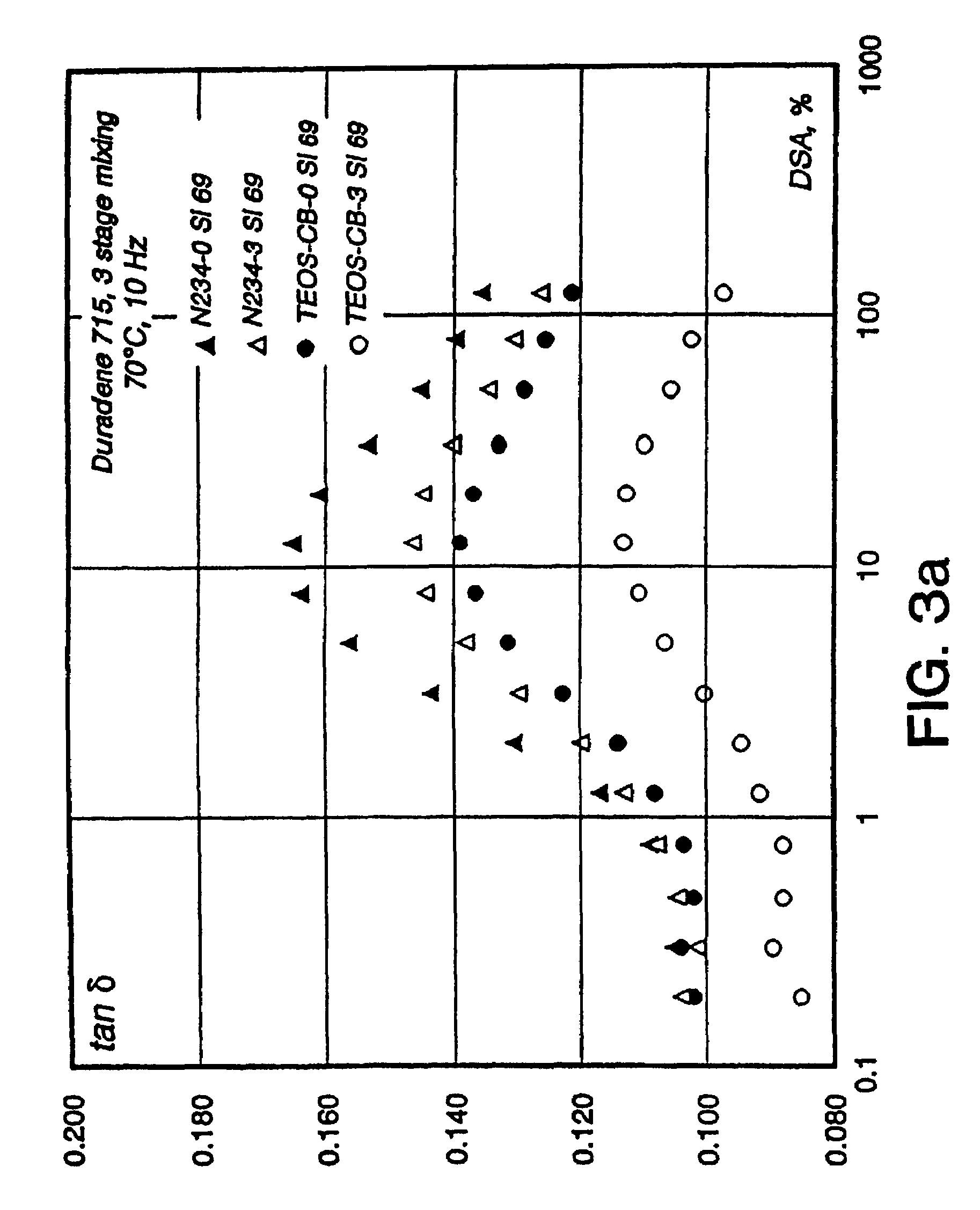Elastomeric compounds incorporating silicon-treated carbon blacks
- Summary
- Abstract
- Description
- Claims
- Application Information
AI Technical Summary
Benefits of technology
Problems solved by technology
Method used
Image
Examples
example 1
[0095]Silicon-treated carbon blacks according to the present invention were prepared using a pilot scale reactor generally as described above, and as depicted in FIG. 1 and having the dimensions set forth below: D1=4 inches, D2=2 inches, D3=5 inches, L1=4 inches, L2=5 inches, L3=7 inches, L4=1 foot and Q=4.5 feet. The reaction conditions set forth in Table 1 below, were employed.
[0096]These conditions result in the formation of a carbon black identified by the ASTM designation N234. A commercially available example of N234 is Vulcan® 7H from Cabot Corporation, Boston, Mass. These conditions were altered by adding a volatilizable silicon-containing compound into the reactor, to obtain a silicon-treated carbon black. The flow rate of the volatilizable compound was adjusted to alter the weight percent of silicon in the treated carbon black. The weight percent of silicon in the treated carbon black was determined by the ashing test, conducted according to ASTM procedure D-1506.
[0097]One...
example 2
[0105]A scanning transmission electron microscope (STEM) coupled to an energy dispersive X-ray analyzer, was used to further characterize the silicon-treated carbon black. The following Table 3 compares N234, OMTS-CB (prepared according to Example 1) and N234 to which 3.7% by weight silica (L90, sold as CAB-O-SIL® L90, by Cabot Corporation, Boston, Mass.) was added to form a mixture. As described below, the STEM system may be used to examine an individual aggregate of carbon black for elemental composition. A physical mixture of carbon black and silica will result in the identification of silica aggregates which show mostly silicon signal and little or background carbon signal. Thus, when multiple aggregates are examined in a mixture, some of the aggregates will show a high Si / C signal ratio, corresponding to aggregates of silica.
[0106]Five mg of carbon black was dispersed into 20 ml of chloroform and subjected to ultrasonic energy using a probe sonicator (W-385 Heat Systems Ultra S...
example 3
HF Treatment
[0109]Hydrofluoric acid (HF) is able to dissolve silicon compounds but does not react with carbon. Thus, if either a conventional (untreated) carbon black or a mixture of silica and carbon black is treated with HF, the surface and surface area of the carbon black will remain unchanged, because it is unaffected by the dissolution of the silicon compounds removed from the mixture. However, if silicon containing species are distributed throughout at least a portion, including the surface, of the carbon black aggregate, the surface area will markedly increase as micropores are formed as the silicon compound is dissolved out of the carbon black structure.
[0110]Five grams of the carbon black to be tested were extracted with 100 ml of 10% v / v hydrofluoric acid for 1 hour. The silicon content and nitrogen surface area were measured before and after the HF treatment. The results are shown in Table 4.
[0111]
TABLE 4HF Treatment% Si% SiN2SAN2SABefore HFAfter HFBefore HFAfter HFTreatm...
PUM
| Property | Measurement | Unit |
|---|---|---|
| Fraction | aaaaa | aaaaa |
| Fraction | aaaaa | aaaaa |
| Fraction | aaaaa | aaaaa |
Abstract
Description
Claims
Application Information
 Login to View More
Login to View More - R&D Engineer
- R&D Manager
- IP Professional
- Industry Leading Data Capabilities
- Powerful AI technology
- Patent DNA Extraction
Browse by: Latest US Patents, China's latest patents, Technical Efficacy Thesaurus, Application Domain, Technology Topic, Popular Technical Reports.
© 2024 PatSnap. All rights reserved.Legal|Privacy policy|Modern Slavery Act Transparency Statement|Sitemap|About US| Contact US: help@patsnap.com










